Giant MF 1200 spotted in the wilds of Shropshire!
Posted by Chris Graham on 15th May 2024
Paul Hillage is a big Massey Ferguson machinery fan and particularly likes the 1970s classic MF 1200, as Bob Weir discovers.
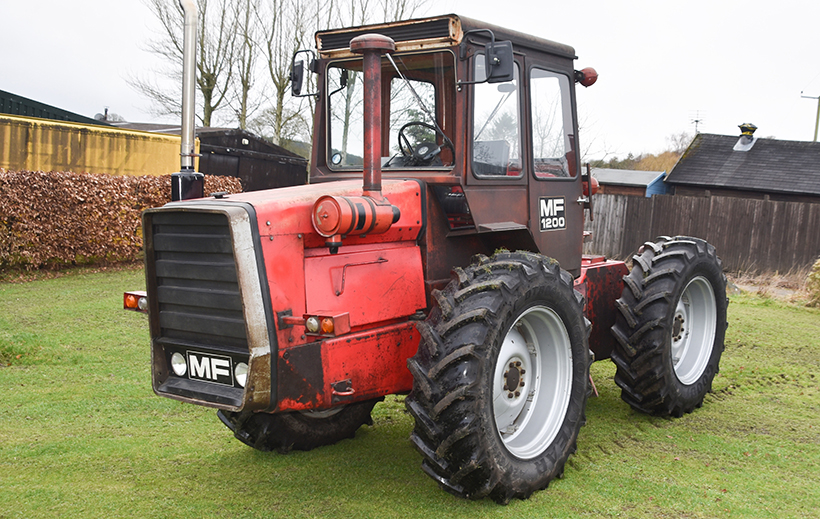
MF 1200: Paul Hillage is delighted with his giant Massey Ferguson, and says that the tractor is fun to drive and has a real road presence.
Shropshire is renowned for its agriculture and tractors are a way of life for many there. The county is well-known for being a hotbed for classic machinery, and a lot of older Massey Fergusons are still putting in a good day’s shift. The MF 1200 seems to be a particular favourite in the area, and is a familiar sight at rallies and on road runs.
Paul Hillage is a professional mechanic, and has lived in the area all his life. “Although I don’t come from a farming background, I’ve been around tractors since I was a boy,” he explained. “I remember seeing a 1200 when I was growing up, working on a farm in the same village. I always liked the look of the tractor and, once I was older, I decided to buy one when the opportunity came along.”
First classic
The MF 1200 is Paul’s first classic tractor, and he has owned it for 13 years. “It was registered in 1976 and I spotted it in an advertisement in the classified section of this magazine,” he told me. “It came off a farm in Evesham, and after I’d phoned the owner for a chat, I drove down to Worcestershire to check it out. The condition was pretty much as you see it now, although I have fitted a set of new tyres. I’ve also tidied up the paintwork, which was starting to look a little tired.”
The MF 1200 was a popular tractor in its day and was equally well suited to both three-point linkage and drawbar work. It was certainly a stand-out design, with its central pivot configuration and four equal-sized wheels. Factor in a well-proven Perkins engine, transmission and hydraulic system, and the tractor’s success was all but assured.
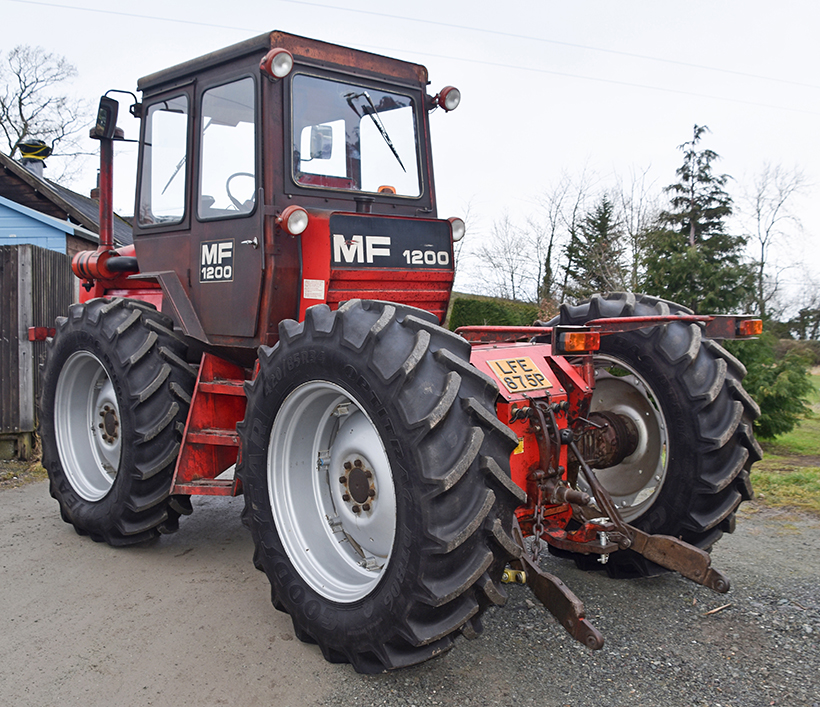
The MF 1200 was a multi-purpose machine and could do three-point linkage and drawbar work.
As you might imagine, though, the MF 1200 certainly raised a few eyebrows when it was launched, as its looks were reminiscent of Doe’s Triple D. But it was very different from other British tractors of the period, and whatever the thinking behind the design, the new machine certainly appealed to owners of large arable farms.
The cab, engine and transmission were all positioned at the front of the tractor, while the hydraulics, PTO and three-point linkage were located at the rear. Although, at first glance, the MF 1200 looked a little front-heavy, there was method behind the concept. The bulky front-end handled 68% of the tractor’s total weight, but equilibrium was established once a mounted implement was put to work on the back. The result was a 50-50 weight distribution that delivered ideal traction from each of the four large wheels.
However, keeping a new model’s size to the minimum was an important concept for Massey Ferguson at the time. The company was a great believer in limiting overall weight in a bid to minimise fuel consumption, while not compromising on the machine’s traction or manoeuvrability.
The MF 1200’s pivot point offered 42° of movement in either direction, as well as an impressive turning radius of 12 feet, which was similar to the company’s two-wheel-drive tractors. The fulcrum also allowed the rear section to oscillate 15° either side of centre, so that all four wheels could be kept on the ground, thereby maximising overall grip. This was considered to be a major advantage, especially when the tractor was working on sloping or undulating ground.

Despite its high profile, the 1200 is easy to access. Excellent visibility is a big plus point.
From a farmer’s point of view, there were other positives, too. For a start, the controls and dials were all familiar and made in the UK, and the visibility from the lofty driver’s seat was excellent. The large areas of glass ensured an uninterrupted view as well as a bright and airy interior. In addition, the hydraulics and Multi-Power transmission were first class, giving the operator the sort of practical versatility that enabled any kind of work to be undertaken with ease. This was in contrast to a lot of the American 4WD competition.
As a result, the MF 1200 quickly acquired a reputation for coping well with heavy soil conditions, particularly when paired with Massey Ferguson’s Huard-based four-furrow, reversible plough. Fortunately, for owners, the big machine was equally at home tackling light top work, such as rolling. What’s more, the tractor’s competitive top speed also made easy work of trailer duties, although manoeuvring the giant Massey into tight spaces took a little practice!
A fine career
Like a lot of its predecessors, the MF 1200 enjoyed a fine career, without any major issues. The model was built at Massey Ferguson’s Barton Dock Road site, alongside some of the company’s construction equipment. The 1200’s success carried on into the MF 1250, which was launched in 1980, and was of a similar design and delivered equally impressive performance.
Anyway, back to Paul’s story. Having come to a deal and bought the tractor, he arranged to have it delivered to his home in Shropshire. “Looking back, I was quite excited as the 1200 was my first tractor,” he recalled. “Although it took three weeks to arrive, it was still in the same condition as when I’d seen it, and the engine started at the first attempt.”
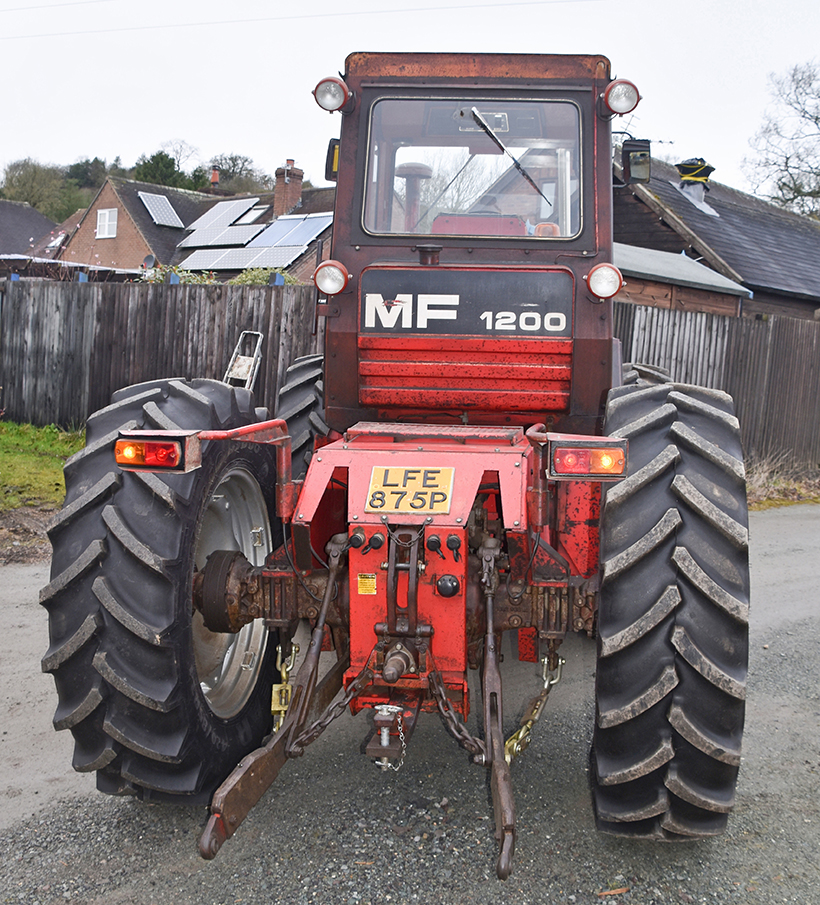
The tractor’s paintwork has been refreshed and its Perkins engine rebuilt during Paul’s ownership.
Although Paul was pleased with the overall condition of the tractor, he decided that the Massey would benefit from a quick makeover. “The paint had faded (quite common on Massey Ferguson tractors from the 1970s), so I decided to start by sprucing that up a bit. I also opted to rebuild the engine, as it was sounding a bit worn, smoking noticeably and using a lot of oil. During that process, I fitted new pistons and liners. Currently, the meter indicates that the engine has run for just 4,147 hours, although, of course, I can’t be sure that that’s accurate.”
Being a mechanic was obviously a big help with this project, and Paul says that the whole job only took him a fortnight. “I got all the parts locally from Billcar Precision Engineering Ltd, in Shrewsbury. Although I did most of the work myself, Bill did sort out the cylinder head for me. That work was done a few years ago now, but the engine’s still running really well. As far as I know, the tractor is also still using its original brakes.”
A DIY approach
As you might imagine, Paul happily tackles all his own servicing and maintenance, and the MF 1200 is kept under cover. “Collectors are always concerned about the bodywork on old tractors, and it’s important to keep them out of the weather,” he explained. “Although the winters are usually quite mild in this part of Shropshire, we do get a lot of rain.”
Like a lot of enthusiasts, Paul keeps the Massey under wraps during the winter months, and then the tractor is readied for action during the spring. He enjoys using the tractor on local road runs, and taking it to shows.
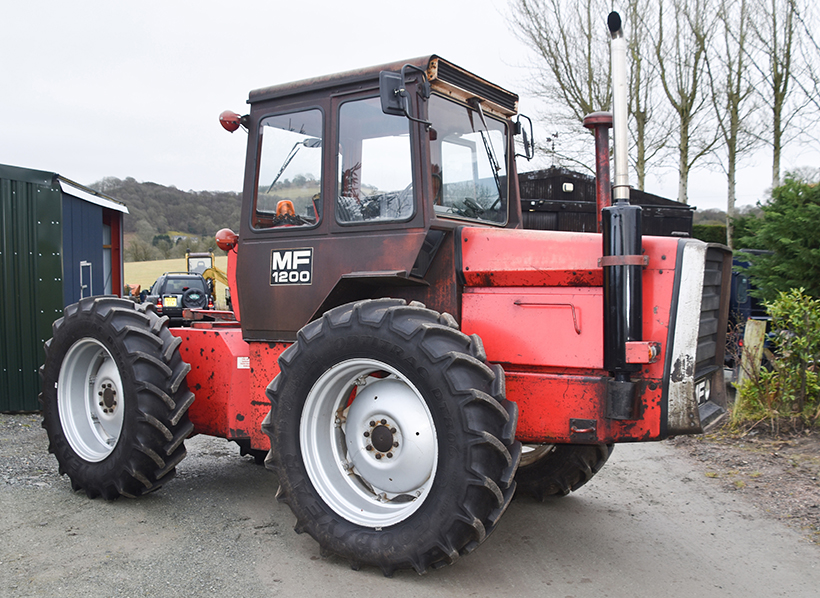
Perhaps it was the equal-sized wheels, or maybe the bright red livery – but with that pivot in the middle, the MF 1200 just looked good fun to drive.
“My favourite event is probably the annual, August Bank Holiday show at Onslow Park, near Shrewsbury,” he told me. “This event is run by the County of Salop Steam Engine Society (COSSES) and is the largest of its kind in the area. Fortunately, I know one of the organisers, and the 1200 usually gets to flex its considerable muscles in the working field.”
The working field is one of the highlights of the show, and caters for tractors of all ages. “The crowd is very knowledgeable at this show and it really is a great weekend out,” said Paul. “The oldest machine at last year’s show dated from 1916, and there were also plenty of Ferguson and Massey Ferguson tractors on display. Obviously, it’s better if the weather is good, but you can’t always guarantee that with the English summer!”
Paul usually pairs the MF 1200 with a cultivator. The ground is quite heavy in that part of Shropshire, and the work certainly puts the Massey through its paces. “I also enjoy the occasional tractor run,” he added. “The local countryside is quite hilly, although the 1200 takes most things in its stride. Although it was quite nimble in its day, the tractor is a bit on the slow side by modern standards, although it always gets there in the end. There are also a lot of narrow and winding roads in the area, so you have to keep your wits about you. Visibility from the cab is obviously good as you’re sitting so high up and, of course, I’m under cover. That’s no bad thing, especially when the rain is bucketing down!”
Paul enjoys driving the MF 1200, and says it’s a lot of fun. “One of the highlights of the design, as far as I’m concerned, is that the back wheels follow the front wheels exactly,” he said. “It also helps that all four wheels are the same size. The 1200’s 4WD system also means that it has a very tight turning circle. The steering is light which helps a lot with overall manoeuvrability. The Multi-Power transmission works OK and is easy to use, and braking is straightforward whether the tractor is on a slope or a straight line. The reliable Perkins A6.354 has plenty of grunt, even if it’s a bit on the slow side. All said and done, the 1200 is a nice drive.”
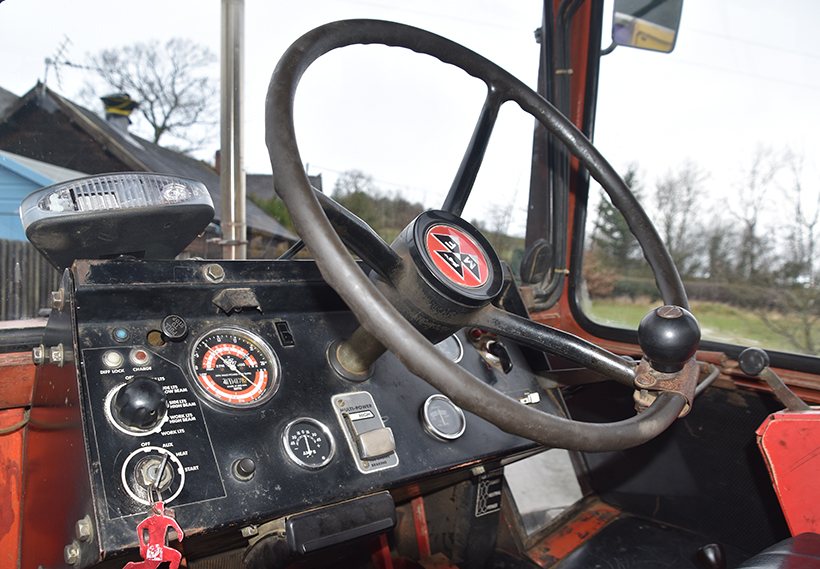
All the controls are straightforward and fall easily to hand, and the instruments were made by familiar names like Smiths Industries
Paul is very happy with the MF 1200 and intends hanging on to it for the near future. In addition, he’s recently bought a MF 2685, but that’s another story!
Perkins engines: a brief history
F Perkins Limited was founded in Peterborough by Frank Perkins and Charles Wallace Chapman on June 7th, 1932. The pair would transform the outlook for diesel engines.
Prior to Chapman and Perkins, the diesel engine was considered a cumbersome workhorse, but Chapman’s concept of a high-speed engine to rival petrol units revolutionised the idea of diesel power. The company was soon breaking diesel world speed records, and went on to introduce the now famous P4 and P6 engines around the outbreak of the Second World War.
The company went public at the end of hostilities, and was soon issuing licenses all over the world. It was eventually bought by its largest customer, Massey Ferguson, in 1959, although it retained its own identity. Ownership changed again in 1994, when Perkins Engines became a subsidiary of LucasVarity.
The 6.354 power plant was one of the company’s most popular engines, and was a compact unit despite its in-line six-cylinder design. Early examples could deliver up to 112hp (84kW), although this was boosted to 120hp in later versions. Key to the engine’s success was a small jackshaft driven by the timing gears for the auxiliary drive, while the oil pump used a quill shaft. This allowed it to run auxiliary equipment via simple couplings.
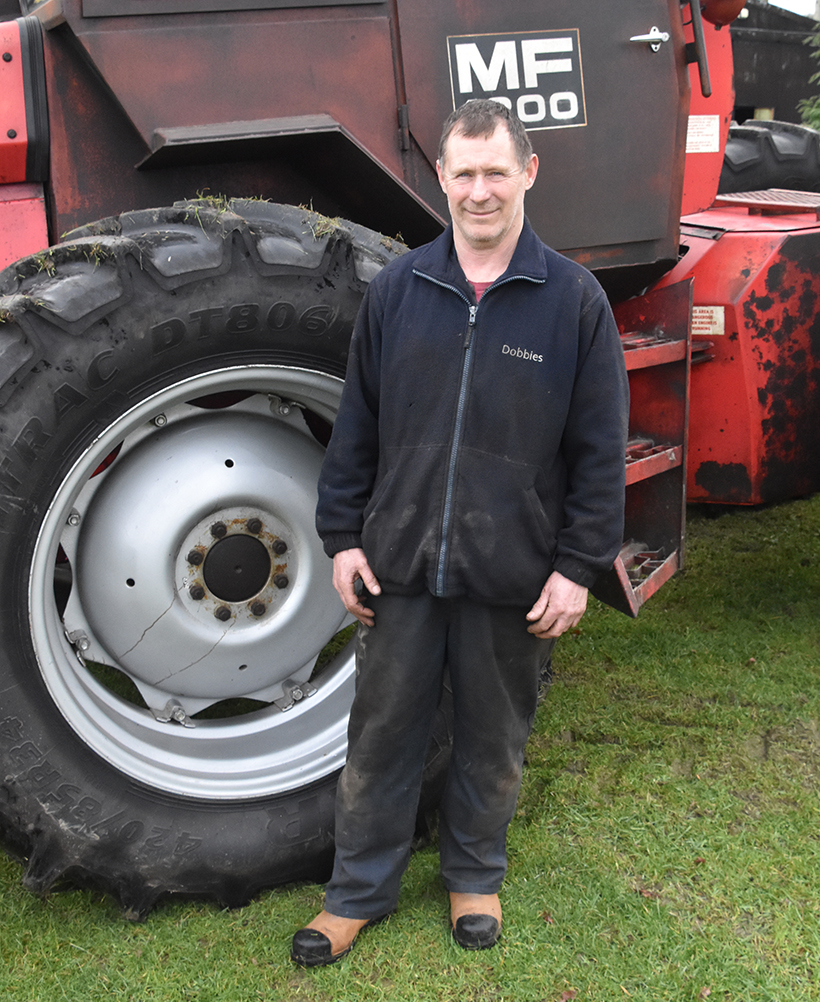
Paul Hillage is a Massey man, through and through.
Like all engine manufacturers, Perkins was faced with the challenge of meeting stricter emissions. During this period the company also developed a new engine series for power generation and forklift truck applications. Various manufacturers continued to use Perkins engines, and the company established a worldwide profile. Perkins was bought by Caterpillar in 1998, creating what was believed to be the world’s largest diesel engine manufacturer.
Nowadays, Perkins engines are common in a wide range of machinery, including tractors. They are mainly used by parent company Caterpillar, and the subsidiary Perkins Marine. There are production facilities in several countries.
Tech specs
| Built: | 1972-79 |
| Engine: | Perkins A6.354 |
| Cylinders: | 6 |
| Bore/stroke: | 3.9in x 5.0in |
| Power: | 105hp |
| Displacement: | 354cu in |
| Torque: | 264lb/ft @1,400rpm |
| Transmission: | 12 forward, 4 reverse |
| Speed range: | 1.2-17.4mph |
| Linkage: | Category II |
| Lift capacity: | 7,496lbs |
| Weight: | 11,367lbs |
| Tyres: | Front: 12.8×38 Rear: 12.8×38 |
This feature comes from the latest issue of Classic Massey & Ferguson Enthusiast, and you can get a money-saving subscription to this magazine simply by clicking HERE
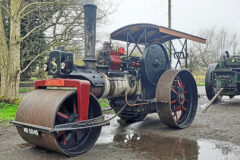
Previous Post
1924 Aveling & Porter roller making great progress

Next Post
We visit the superb British Commercial Vehicle Museum



